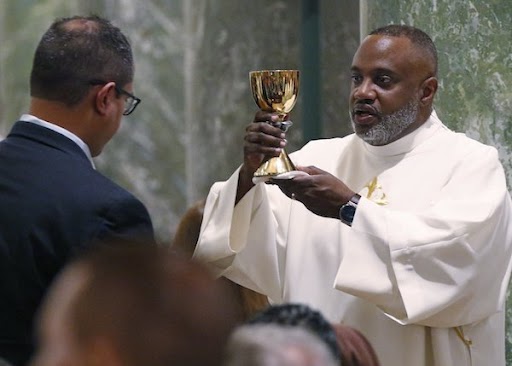
WASHINGTON — When the COVID-19 pandemic first hit the United States in 2020, U.S. dioceses put liturgical restrictions in place, such as no longer using the Communion cup, to avoid potential germs with a shared vessel.
But now, with the pandemic waning, many bishops have announced that parishes in their dioceses can resume offering the chalice of consecrated wine at Communion.
Some dioceses started doing this last year, others made the change recently, effective Holy Thursday.
At least 25 dioceses or archdioceses have resumed offering Communion in both forms as of Easter. The Archdiocese of New York resumed this practice in February, and the Archdiocese of Newark followed a month later. The Diocese of Brooklyn has not yet announced any decision regarding when they might resume the practice.
In the Newark Archdiocese, directives for this return were issued on March 16 by the archdiocesan Worship Office and approved by Cardinal Joseph Tobin. The directives were to be implemented by parishes by Holy Thursday at the earliest and no later than Pentecost Sunday, May 28.
“Although it is not required, taking from the cup is considered a fuller participation in the Eucharist and a direct response to Jesus’ command to take and drink,” said Father Tom Dente, the director of Newark’s Office of Worship.
The directive also urged parishes to revitalize their worship, inviting back ministers who stepped down during the pandemic and installing additional ones where needed. It even stressed the need to return to pre-pandemic liturgical music and to bring back holy water fonts.
In the Archdiocese of New York, Father Matthew Ernest, archdiocesan director of the Office of Liturgy, said on Feb. 27 that “given the easing of restrictions associated with the COVID-19 public health emergency, the distribution of the Precious Blood may be reintroduced into parish Masses at the pastor’s discretion.”
He said returning to this practice gives parish communities an opportunity “to reflect on the spiritual meaning of this sacred action established by the Lord Himself, to offer Eucharistic catechesis to members of the faithful, and to refine parish liturgical practices in accordance with ecclesial norms.”
Father Ernest, on the archdiocesan website, said that the General Instruction of the Roman Missal offers a summary of the theology behind receiving Communion under two species.
It says: “Holy Communion has a fuller form as a sign when it takes place under both kinds. For in this form, the sign of the Eucharistic banquet is more clearly evident, and clearer expression is given to the Divine Will by which the new and eternal Covenant is ratified in the Blood of the Lord.”
Father Ernest noted that the “distribution of the Precious Blood underscores the nature of the Eucharist as spiritual food and drink given to sustain and build up the pilgrim Church on earth.”
He said he hoped the reintroduction of the consecrated wine at Communion would provide the chance, particularly at this time of national Eucharistic revival, to “reflect on the great gift of the Eucharist, the Real Presence of Christ Himself, to the People of God.”
Across the country, in the Archdiocese of Galveston-Houston, Texas, Cardinal Daniel DiNardo restored the practice of holy Communion from the chalice in January.
He said some of the faithful may not be comfortable receiving the Eucharist under this form due to health concerns and reminded Catholics that the reception of holy Communion from the chalice is always at the discretion of the communicant.
Dan Girardot, an associate director of Liturgical Formation in the Office of Worship for the diocese, noted that some may have “valid reservations about receiving from the chalice.”
In response to potential questions about the possible spread of germs from sharing the chalice, he said: “Professional, peer-reviewed medical research from epidemiologists concluded that there is no known outbreak of disease directly related to this liturgical practice.” He did suggest that individuals with an illness refrain from receiving Communion from the chalice.
The Archdioceses of Washington and Baltimore and the Diocese of Honolulu reinstituted the reception of Communion under both species on Holy Thursday, linking it to that day’s institution of the Eucharist as the true body and blood of Jesus Christ.
The Catholic Review, the news outlet for the Baltimore Archdiocese, spoke with some archdiocesan priests in early April about returning to the Communion cup, and some expressed concern about it.
One priest said he didn’t know if his parishioners were ready for it, another similarly felt people might be hesitant to receive from the cup, but the parish would offer it.
In a March 6 memo to all Hawaii clergy, religious communities, and parishes, Father Alfred Omar Guerrero, director of Honolulu’s diocesan Office of Worship, explained that pastors have the final say on bringing back the Communion cup in their parish.
His memo reminded pastors that they can re-educate parishioners on “concomitance,” the Catholic belief that “under each species alone, the whole Christ is sacramentally present, and we receive all the fruit of Eucharistic grace.”
Receiving just the consecrated host or just the Precious Blood is equally acceptable.
Father Anthony Rapozo, pastor of St. John the Apostle and Evangelist in Mililani, told the Hawaii Catholic Herald that even though the Communion cup was returning to his parish, he planned to make sure to remind people that “we are restoring the cup, but you’re not required to partake of it if you’re not comfortable.
“You still receive the fullness of the sacrament, whether you can only consume the sacred host or if you cannot take the host and you can only consume the precious blood because some people are allergic,” he said. “You still get the fullness of the sacrament.”
